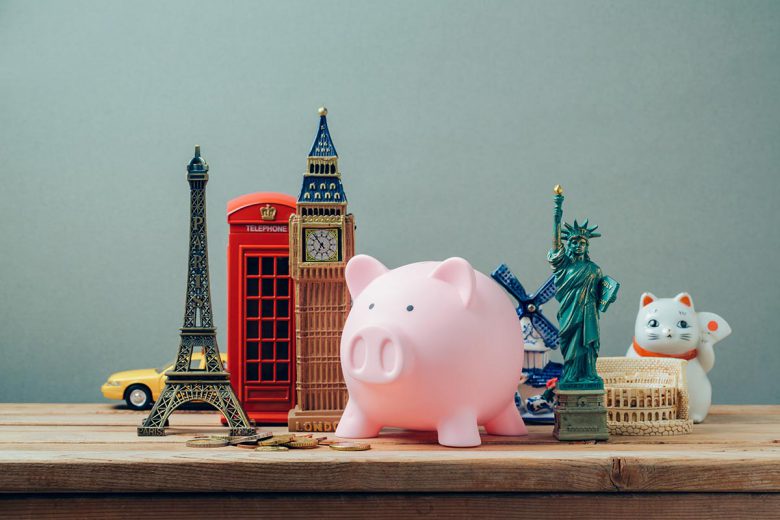Whether it’s trekking through South America, exploring the jungles of South-East Asia, or wandering through the streets of Europe, deciding what kind of gap year to take is a personal choice. But regardless of what you choose to do, creating and sticking to a budget is essential. Because at the end of the day, the kind of gap year you choose to go on will largely shape the amount of money you’ll need.
The costs of a gap year
The first step to planning your ultimate gap year on a budget is to get an idea of how much everything is going to cost. The key thing to remember, though, is that even the cheapest gap years can provide the most wonderful and unforgettable experiences.
Passport and visa fees are a good place to start when it comes to budgeting. If you don’t already have a passport, it’s time to get one. This will come at a cost of $293, and there’s a lot you won’t be able to book until your passport is sorted so it’s important to get this done early in the process. Depending on the countries you wish to visit and if you want to work your way through your gap year, you also might need to apply for visas – tourist or working. Again, the visa application comes with a fee, so always factor that in.
There’s also the cost of flights, accommodation, and program fees (if you’re choosing to go with a formalised group) to factor in. The cost of your flights and accommodation will depend on where you’re going, for how long, and what kind of accommodation you wish to stay in. If you’re on a tight budget, there are ways to keep the accommodation costs down, such as staying in hostels, finding home-stays or couch-surfing.
It’s also important to consider the cost of insurance. Any time you travel, you’ll need to have travel insurance. This is because you never know what may happen while you’re away, from having things stolen, to flight changes and even getting sick.
Finally, you must budget for your spending money. Costs to consider include transport at your destination, seeing the tourist sights, meals, and any recreational activities or shopping you plan to do.
How to have fun on a gap year on a budget
When you’re in the thick of planning your gap year, budgeting doesn’t seem that exciting. But just because you’re travelling on a budget doesn’t mean you won’t have fun. In actual fact, it can be said that the cheaper the trip, the more fun you’ll have, purely because you make your own fun. So, here are some tips for budgeting during your gap year that will still allow you to have fun:
Find cheap places to stay
Some of the most interesting accommodation options are actually the cheapest. Think farm-stays or meeting people through couch-surfing websites, or even camping.
Volunteer
Volunteering can be a low-budget way to really immerse yourself in the culture and community of the local region. Sometimes, the volunteering place will even provide food and board.
Be flexible
Flexibility during your gap year can actually help keep costs down. The more adaptable you and your arrangements are, the more likely you’ll be able to take up the offer of last-minute discounts and loopholes.
Travel overnight
Travelling through the night means you have one less night to pay for accommodation and it gives you a full day to explore the area you’re in – a win-win.
Speak to the locals
Talking to the locals gives you an in-depth and personal insight into the city and country you’re in. Plus, they’ll know the best and cheapest ways to get around, things to see, and places to eat. As an added bonus, you may even make some friends who’ll offer you a place to stay or a meal or two.
Try to travel off-peak
Of course you want to see a destination during the best possible time of year, but this can hike up all the fees. Avoid school holidays and try to travel during the shoulder season.
Be smart about where you get your money
Avoid changing money at airports. Instead, find a place in the inner city to exchange your money.
Use an app
Put your budget into a budgeting app and keep track of every expense. This way, you’ll stay on top of your budget and be able to keep track of exactly where your cash is going.
Take some free classes
Whether it’s a morning yoga class or some lessons in the local language or cuisine, many places will offer free classes. These are great ways to experience the culture and they don’t cost a cent. There are also some tourist sights that offer ‘free’ or ‘cheap’ days.
Avoid the tourist traps
Obviously you want to see all the tourist destinations, but there’s so much more to a place than its most well-known sights. Travelling off the beaten track usually provides some hidden gems and it’s usually much cheaper than the popular tourist destinations.
Consider how you’ll get around
Public transport is an affordable option when compared to taxis and ubers, but investigate whether you can hire a bike or even a segway for the day for cheap too. You’ll get some exercise and it’s a great way to enjoy the outdoors while seeing the city.
Take your own food
When exploring, take a few sandwiches and snacks with you for the day. This covers lunch and means you won’t be tempted to grab something expensive on the go when your tummy starts to growl.
Budgeting starts before you leave
Before you depart, start saving your pennies by cutting out costly habits such as eating out and shopping. Find free or cheap entertainment, stay in more, and cancel any memberships you don’t use.
Before you leave, decide on your destination, research the costs, and create a budget of everything you think you’ll need to pay for. Take this with you so you can always refer to it. Then, along the way, if you’re overspending, you can figure out how and where to cut back.
While cutting back on expenses at home sounds easy, sometimes it’s not enough. If you need a little helping hand, speak to SRG Finance about taking out a small loan.



